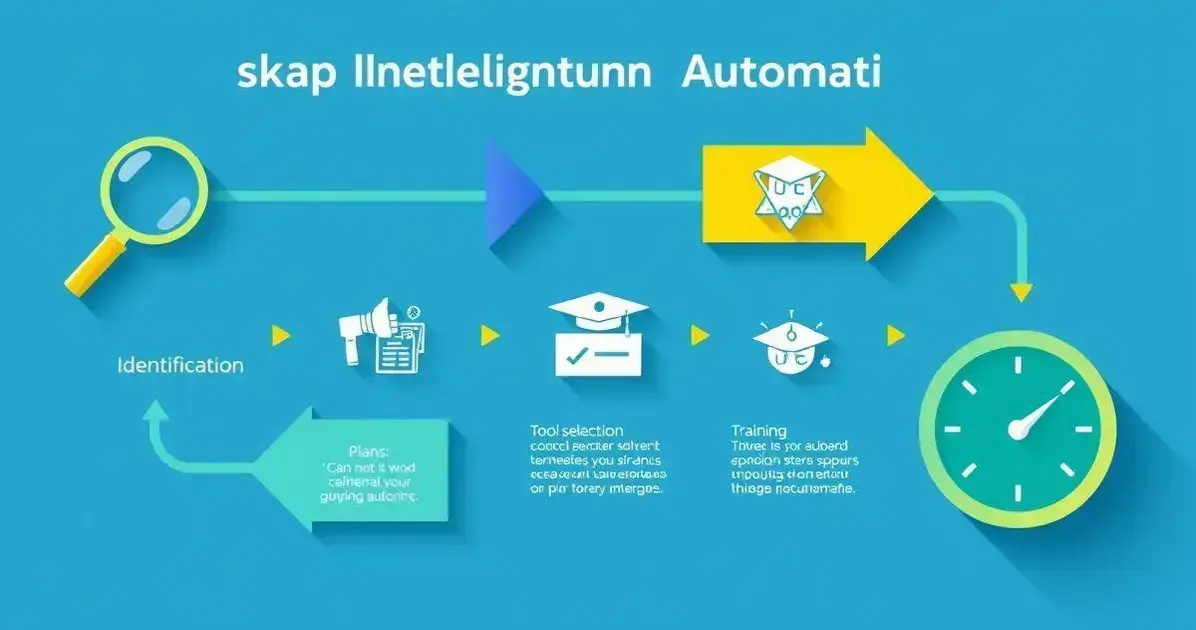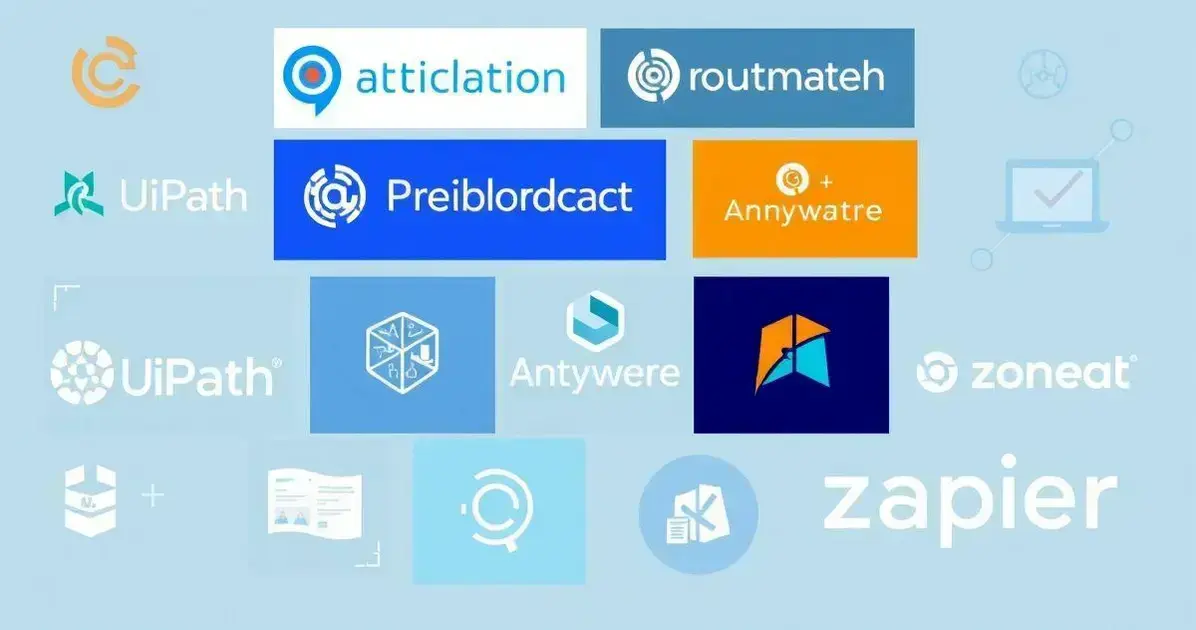Announcements
Intelligent automation is the future, blending artificial intelligence with automated processes to optimize efficiency and drive innovation.
This powerful combination is transforming industries, making organizations more agile and responsive to changing market demands.
In this post, we will delve into the various aspects of intelligent automation, its benefits, implementation strategies, and real-world success stories that showcase its potential.
Announcements
What is Intelligent Automation?
Intelligent automation refers to the combination of advanced technologies such as artificial intelligence (AI), machine learning, and robotic process automation (RPA) that work together to automate tasks in a more sophisticated way.
Unlike traditional automation, which relies on pre-defined rules, intelligent automation can adapt to new situations, learning from data and making decisions on its own.
Announcements
What Makes Intelligent Automation Unique?
The uniqueness of intelligent automation lies in its ability to improve decision-making and enhance overall efficiency. By analyzing large volumes of data, intelligent systems can identify patterns and optimize processes that were previously manual or inefficient.
Core Components of Intelligent Automation
The main components include:
- Machine Learning: Systems learn from data to improve their performance over time.
- Natural Language Processing (NLP): Machines can understand and respond to human language, enabling better communication.
- Robotic Process Automation: Routine tasks are executed by software robots, reducing human error.
When these technologies are combined, they create a powerful synergy that enables organizations to transform how they operate and deliver value.
Applications Across Industries
Intelligent automation is applicable in various sectors, from finance to healthcare. For example, it can streamline processes like claims processing in insurance or patient data analysis in healthcare, ultimately leading to faster and more accurate outcomes.
Benefits of Intelligent Automation
Intelligent automation offers numerous benefits that can significantly enhance the workflow and productivity of organizations. By integrating AI and automation, businesses can streamline their operations, reduce costs, and improve service quality.
1. Increased Efficiency
One major benefit of intelligent automation is its ability to automate repetitive tasks. This not only saves time but also allows employees to focus on higher-value activities that require human insight.
2. Cost Savings
Implementing intelligent automation can lead to substantial cost reductions. By automating manual processes, organizations can minimize errors, reduce labor costs, and optimize resource allocation.
3. Improved Accuracy
Human errors are common in manual tasks. Intelligent automation enhances accuracy by following defined algorithms, which results in fewer mistakes and higher quality outcomes.
4. Better Customer Service
With intelligent automation, businesses can provide quicker responses to customer inquiries and issues. This can improve customer satisfaction and foster loyalty, as clients appreciate timely and efficient service.
5. Scalability
As businesses grow, the demands on processes increase. Intelligent automation allows for easy scalability. Organizations can add more automated systems without significantly increasing costs or resources.
6. Enhanced Data Analysis
Intelligent automation can analyze massive amounts of data quickly and accurately. This enables companies to make informed decisions based on real-time insights and trends.
7. Increased Agility
Organizations adopting intelligent automation can respond faster to market changes. This agility allows them to remain competitive and meet customer expectations swiftly.
How to Implement Intelligent Automation

Implementing intelligent automation can transform an organization’s operations significantly. Start with a clear plan and follow these key steps to ensure success:
1. Identify Key Processes
Begin by identifying processes within your organization that are repetitive and time-consuming. Focus on tasks that can benefit from automation, such as data entry, report generation, or customer service inquiries.
2. Set Clear Objectives
Establish specific goals for what you want to achieve with intelligent automation. These could include reducing processing time, improving accuracy, or enhancing customer satisfaction. Clear objectives help measure success.
3. Choose the Right Tools
Select appropriate tools and technologies that fit your business needs. Research solutions that combine AI and automation, ensuring they integrate well with your existing systems.
4. Start Small
Implement a pilot project first. Choose a manageable process to automate. This allows you to assess effectiveness and make adjustments before scaling up.
5. Train Your Team
Provide adequate training for your employees. It’s important they understand how to use the new tools effectively. Encourage a culture of adaptability to help them embrace changes.
6. Monitor and Measure
After implementation, monitor the performance of your automated processes. Measure against the objectives you set in the beginning. Collect feedback and adapt as necessary.
7. Scale Gradually
Once you’re satisfied with the results of your pilot project, consider rolling out the automation across other areas of your business. Gradual scaling helps minimize disruption and allows you to refine your approach.
Challenges in Intelligent Automation
While intelligent automation provides many advantages, there are also several challenges organizations face when implementing these technologies. Understanding these obstacles is crucial for successful integration.
1. Resistance to Change
Employees may be apprehensive about automation taking their jobs. This resistance can hinder the adoption of new technologies. It’s important to communicate clearly about how automation will assist rather than replace human workers.
2. Complexity of Implementation
Implementing intelligent automation can be complicated. Integrating new systems with existing workflows requires careful planning and technical expertise. Companies may need to invest in training or hire specialists to ensure a smooth transition.
3. Data Privacy Concerns
When using AI and automation, organizations often handle sensitive data. There are significant data privacy concerns that must be addressed to protect customer information and comply with regulations.
4. High Initial Costs
Intelligent automation solutions can come with a hefty price tag. Companies may face substantial upfront costs related to software, hardware, and training. This financial barrier can be intimidating for some organizations.
5. Maintaining Human Oversight
Even though automation can handle many tasks, it’s vital to have human oversight. Over-reliance on automation can lead to challenges in quality control and the deterioration of problem-solving capabilities in staff.
6. Keeping Up with Technology
The technology landscape is constantly changing. Organizations need to stay updated on the latest developments in intelligent automation. This rapid advancement can make it difficult for companies to choose the right tools and stay competitive.
7. Measuring Success
Evaluating the effectiveness of intelligent automation can be challenging. Organizations need to establish clear metrics and benchmarks to assess the impact of implemented solutions accurately. This ensures that the benefits of automation are not overlooked.
Future Trends in Intelligent Automation
The future of intelligent automation is promising, with several trends shaping how businesses will operate moving forward. Here are key trends to watch:
1. Increased AI Integration
Businesses will increasingly integrate AI capabilities into their automation processes. This will enhance decision-making and enable automation systems to learn and adapt over time, making them more effective.
2. Greater Focus on Data Analytics
Organizations will leverage big data and analytics to optimize their automation strategies. This allows companies to make data-driven decisions and continuously improve their automation workflows.
3. Rise of Hyperautomation
Hyperautomation focuses on automating as many business processes as possible. This trend emphasizes collaboration between various technologies, creating a seamless automation ecosystem that delivers higher efficiency.
4. Enhanced User Experience
Future intelligent automation solutions will prioritize user experience. By simplifying interfaces and making systems intuitive to use, organizations can ensure that employees can achieve results quickly and efficiently.
5. Automation in Emerging Technologies
Emerging technologies like 5G and the Internet of Things (IoT) will enhance intelligent automation by providing faster data processing and connectivity. These technologies will open new opportunities for automation in real-time applications.
6. Ethical Automation
There will be a growing emphasis on ethical considerations in automation. Companies will need to address transparency and accountability in how they deploy automation technologies, paying attention to the effects on jobs and society.
7. Continuous Learning and Adaptation
The future will demand systems that continuously learn from their environments. Intelligent automation will evolve to focus on ongoing training of AI models to ensure they remain effective and relevant in changing conditions.
Best Tools for Intelligent Automation

Choosing the right tools for intelligent automation is critical for enhancing business operations. Here are some of the best tools available:
1. UiPath
UiPath is a leader in robotic process automation (RPA). It has a user-friendly interface, making it easy for businesses to automate repetitive tasks without extensive coding skills.
2. Automation Anywhere
This platform offers a comprehensive suite of RPA tools that help companies automate workflows across various applications. It also includes advanced AI capabilities to enhance automation.
3. Blue Prism
Blue Prism focuses on enterprise-grade automation. Its software allows businesses to build and manage a digital workforce, ensuring efficiency and compliance in processes.
4. Microsoft Power Automate
Part of the Microsoft Power Platform, this tool allows users to automate workflows between Microsoft services and third-party applications, increasing productivity across platforms.
5. ServiceNow
ServiceNow offers a robust automation solution for IT and business processes. It streamlines service delivery and integrates with various applications to enhance operational efficiency.
6. WorkFusion
WorkFusion combines RPA with cognitive automation. This allows organizations to automate both structured and unstructured data processes, making it ideal for complex business environments.
7. Zapier
Zapier is perfect for small businesses and startups. It connects various apps and automates tasks between them, making it easy to manage workflows without needing extensive technical skills.
8. IBM Watson
IBM Watson is an AI-driven platform that offers intelligent automation solutions. It provides advanced data analytics and machine learning features, helping organizations automate and optimize their processes.
Real-World Examples of Intelligent Automation
Many companies are successfully harnessing intelligent automation to improve their operations. Here are some compelling real-world examples:
1. Amazon
Amazon uses intelligent automation in its warehousing and logistics processes. Automated robots help move products, and AI predicts the best delivery routes, increasing overall efficiency.
2. Siemens
Siemens employs intelligent automation to streamline its manufacturing processes. By integrating AI and robotics, they significantly reduce production times while maintaining high quality standards.
3. Coca-Cola
Coca-Cola utilizes automated systems for inventory and supply chain management. Intelligent forecasting tools analyze data to optimize purchasing, ensuring that warehouses are stocked efficiently.
4. Bank of America
This bank uses AI-driven chatbots that automate customer service to handle routine inquiries. This not only improves response times but also allows human agents to focus on more complex issues.
5. Unilever
Unilever leverages intelligent automation in its marketing efforts. Automated tools analyze consumer behavior and preferences to create targeted marketing strategies that engage customers effectively.
6. Netflix
Netflix employs intelligent automation in content recommendations. Their AI algorithms analyze viewing habits to suggest movies and shows tailored to individual preferences, enhancing user satisfaction.
7. Tesla
Tesla utilizes intelligent automation in its production lines. Robots perform repetitive tasks with high precision, and AI helps in optimizing the manufacturing process, leading to faster production times.







